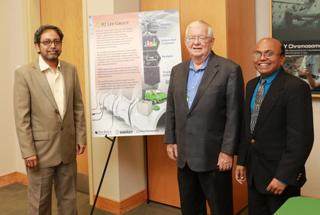Oct 31 2015
RJ Lee Group has signed an agreement to license an invention developed at the Department of Energy's Oak Ridge National Laboratory that converts waste rubber into a valuable energy storage material.
 An ORNL technology that converts waste rubber into a valuable energy storage material has been licensed to RJ Lee Group. ORNL inventors Amit Naskar (left) and Parans Paranthaman flank Richard Lee, CEO of RJ Lee Group. Credit: Oak Ridge National Laboratory
An ORNL technology that converts waste rubber into a valuable energy storage material has been licensed to RJ Lee Group. ORNL inventors Amit Naskar (left) and Parans Paranthaman flank Richard Lee, CEO of RJ Lee Group. Credit: Oak Ridge National Laboratory
The technology turns rubber sources such as tires into carbon black composites through a proprietary pretreatment process invented by ORNL's Amit Naskar, Parans Paranthaman and Zhonghe Bi. The carbon composite material can be incorporated in batteries, supercapacitors, and catalysis and water filtration technologies.
"This process represents a major breakthrough in the utilization of more than two percent of the nation's solid waste and will materially improve the price and performance of advanced energy storage technologies," said Richard Lee, CEO of RJ Lee Group. "We are delighted to collaborate with ORNL in this technology transfer effort. The project symbolizes the ideal relationship between the fundamental research capabilities of the National Laboratory and a small high tech business in commercializing innovative technologies."
The technology could introduce a new market for the one billion scrap tires generated globally each year, which are typically sent to landfills or used as fillers in plastics, rubbers, asphalt, artificial turf and civil engineering applications.
"Our success in producing higher performance carbon composites from waste tire rubber for potential use in energy storage applications adds a new value to recycled tires," Naskar said.
When ORNL researchers tested the recovered carbon in anodes of lithium-ion batteries, the laboratory-scale coin cells had a higher capacity and faster charging rates than that of conventional graphite batteries. Using the carbon black composites as a lower cost alternative to graphite could potentially reduce the cost of lithium ion batteries by 10 percent.
The ORNL team will collaborate with RJ Lee Group to further develop the technology through a privately funded sponsored research project.
"The next step is to scale up the production of the carbon materials so that we can replicate the lab-scale performance in larger format cells," Paranthaman said.
The research on conversion of recycled tires to graphite powders was funded by the laboratory's Technology Innovation Program. The evaluation of the new materials as novel battery electrodes was sponsored by DOE's Office of Science.
Source: http://www.ornl.gov